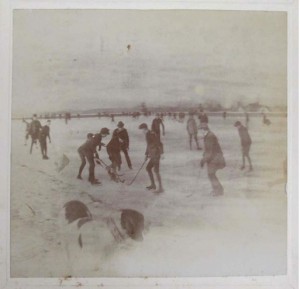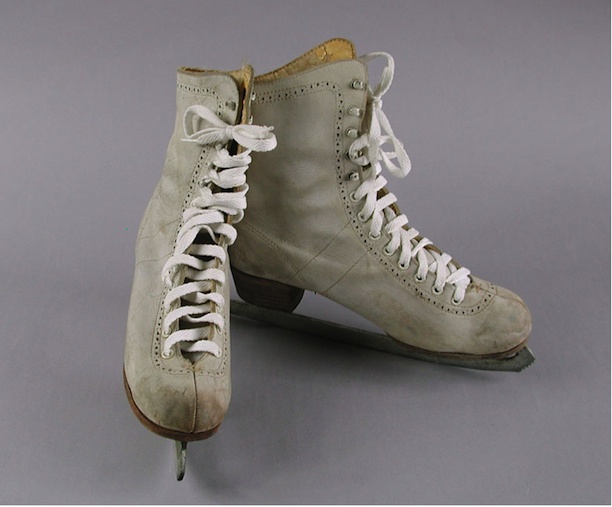by Karen DePauw
The centuries-old tradition of ice skating during the winter season began as a simple way to get from place to place. However, by the 1850s, better-designed skates and the increased interest in outdoor activities made ice skating a popular leisure activity. Skaters might be found on virtually any frozen body of water: small ponds, rivers, even town reservoirs.

Boys Playing Hockey, ca. 1896. This souvenir paperweight from the Connecticut State Building at the 1893 Columbian Exposition shows boys playing hockey on the old Garden Street Reservoir in Hartford – Connecticut Historical Society
Hartford Ice Rink Used Year-Round
Then, in 1869, Hartford built its first skating rink in the city to provide a safe place for its residents to skate. The rink was 80 feet by 200 feet and, according to a newspaper announcement in the Hartford Courant in July of 1869, could accommodate “five or six hundred skaters, all being required to move in one direction around the area.”
The Hartford rink offered more than just a place to skate without worrying about falling through the ice. Ticket prices were set moderately to accommodate skaters of various economic circumstances. And the rink also featured an area for musicians to play during the evening hours. The ice basin was designed to be emptied and covered in summer and autumn allowing for the hosting of large city meetings, or fairs. It could even be fitted with a floor for roller skating in the warmer weather months.
Skating Deemed Suitable for 19th-Century Ladies
Women, as well as men, enjoyed Hartford’s new skating facility. Throughout the 1850s and 1860s, more and more women were being encouraged to participate in outdoor activities. Ice skating, which was considered a healthy form of exercise much like dancing, was among the first activities deemed appropriate for ladies. Often, skirts were shortened slightly to reduce the risk of tripping, though ladies were sometimes advised to wear a longer skirt to and from the pond or skating rink to avoid showing their ankles. A veil was recommended in order to protect the lungs from cold air. Men teaching female friends and relatives to skate were encouraged to do so on quiet, secluded ponds so no one would see the ladies’ awkwardness and distress while learning the new skill.

Francis and Co. Trade Card. Late 19th century. This trade card shows a pair of skates made to attach to a pair of sturdy boots – Connecticut Historical Society
The first ice skates were merely a separate blade that attached to any solidly made shoe or boot with a series of buckles and clamps. Skates like these were used throughout the 1800s and only in the 1900s were skate and boot combined into one unit. The more secure and well-designed skates became, the more activities became possible. With a good pair of skates, one was no longer restricted to skating around in circles. In 1918 an ice skating carnival on the pond at Colt Park featured figure skating demonstrations and skating races with dashes, distance skates, and even a relay. Figure skating and ice hockey became increasingly popular in the 1900s; some talented skaters could now go on to become professional athletes. For most people, however, ice skating remains a source of pure winter fun.
Karen DePauw, formerly a Research and Collections Associate at The Connecticut Historical Society.
© Connecticut Public Broadcasting Network and Connecticut Historical Society. All rights reserved. This article originally appeared on Connecticut History | WNPR News
Note: ConnecticutHistory.org does not edit content originally published on another platform and therefore does not update any instances of outdated content or language.









